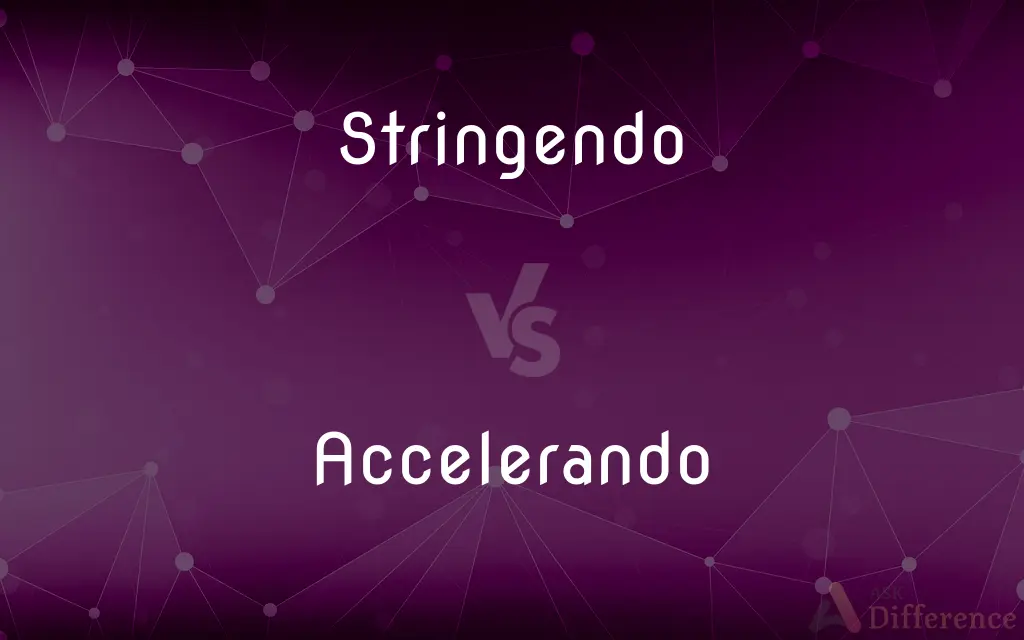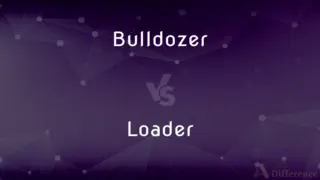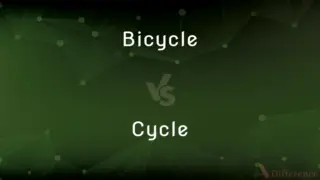Stringendo vs. Accelerando — What's the Difference?
Edited by Tayyaba Rehman — By Urooj Arif — Updated on April 4, 2024
Stringendo refers to a musical direction indicating a gradual increase in tempo, often with an added sense of urgency, while accelerando directs performers to gradually increase the tempo or speed of the music without necessarily implying urgency.

Difference Between Stringendo and Accelerando
Table of Contents
ADVERTISEMENT
Key Differences
Stringendo, in music, implies not only a gradual increase in the tempo but also often suggests an intensification of the music's emotional energy, conveying a sense of urgency or excitement. Accelerando, on the other hand, is a more straightforward instruction to performers to quicken the pace of the music, focusing solely on the aspect of increasing tempo without explicitly affecting the music's emotional intensity.
While both stringendo and accelerando result in a quicker tempo, the context and effect they aim to produce can differ. Stringendo might be used in a passage that requires a build-up of tension or momentum, suggesting that the music should not only speed up but also gain in expressiveness or intensity. Accelerando focuses purely on the technical aspect of speeding up the music, leaving the emotional interpretation more open to the performers' discretion.
The application of stringendo can significantly affect the overall dynamics and expression of a piece, potentially leading to a climactic moment or resolving tension. In contrast, accelerando might be employed to transition between sections, enhance the excitement of a passage, or prepare for a change in musical ideas without necessarily altering the piece's emotional character.
Composers use stringendo to communicate a specific interpretative idea, indicating that the music should become more pressing or urgent. This directive often goes hand in hand with other musical elements, such as dynamics and articulation, to achieve the desired effect. With accelerando, the primary goal is to adjust the tempo to suit the evolving structure or thematic development of the piece, which may or may not involve a change in emotional intensity.
In practice, musicians might find that the distinction between stringendo and accelerando affects their approach to a piece. When executing stringendo, performers might not only increase the tempo but also adjust their playing style to convey the urgency implied by the term. When performing accelerando, the focus would be on the smooth and measured increase in speed, ensuring that the transition in tempo is executed with precision.
ADVERTISEMENT
Comparison Chart
Definition
A directive to gradually increase tempo with added urgency.
A directive to gradually increase the speed of the music.
Emotional Impact
Implies an increase in emotional intensity or tension.
Focuses on tempo change without specifying emotional impact.
Musical Effect
Often used to build momentum or lead to a climactic point.
Used to transition between musical sections or themes.
Focus
Tempo increase combined with expressive intensity.
Purely on the acceleration of tempo.
Execution
May involve changes in dynamics and articulation for emphasis.
Concentrates on the technical aspect of increasing tempo.
Compare with Definitions
Stringendo
Gradually quickening tempo with a sense of urgency.
The stringendo passage added excitement to the finale.
Accelerando
A steady increase in tempo throughout a passage.
The accelerando transitioned smoothly into the next movement.
Stringendo
Used to intensify the emotional energy of the music.
The composer marked the climax with stringendo to heighten the drama.
Accelerando
Focuses on the pace of the music without altering emotional intensity.
The piece featured an accelerando that brought a sense of movement.
Stringendo
Implies a build-up of both speed and expressive intensity.
The orchestra's stringendo brought the audience to the edge of their seats.
Accelerando
Requires precise execution for a smooth tempo transition.
The ensemble handled the accelerando with skill, maintaining cohesion.
Stringendo
Often leads to a climactic moment in the piece.
The stringendo effectively built up to the soaring climax.
Accelerando
Used to enhance excitement or prepare for a change.
The accelerando led seamlessly into the fast-paced finale.
Stringendo
Affects the dynamics and expression of a performance.
The musicians embraced the stringendo, adding fervor to their playing.
Accelerando
Does not necessarily imply changes in dynamics or articulation.
The accelerando was executed with consistent intensity throughout.
Stringendo
Played with an accelerating tempo. Used chiefly as a direction.
Accelerando
Accelerando is a 2005 science fiction novel consisting of a series of interconnected short stories written by British author Charles Stross. As well as normal hardback and paperback editions, it was released as a free e-book under the CC BY-NC-ND license.
Stringendo
(music) A passage in music to be played gradually faster; a section of music with in which the tempo slowly increases.
Accelerando
Gradually accelerating or quickening in time. Used chiefly as a direction.
Stringendo
(music) Played with gradually increasing tempo.
Accelerando
An accelerando passage or movement.
Stringendo
Urging or hastening the time, as to a climax.
Accelerando
(music) A tempo mark directing that a passage is to be played at an increasing speed.
Accelerando
(music) A passage having this mark.
Accelerando
(by extension) Accelerating or exponential advancement or development (of a thing).
Accelerando
(music) With a gradual increase in speed.
Accelerando
Gradually accelerating the movement.
Accelerando
A gradually increasing tempo of music;
My ear will not accept such violent accelerandos
Accelerando
Gradually increasing in tempo
Accelerando
With increasing speed;
Here you must play accelerando
Common Curiosities
How do performers differentiate between stringendo and accelerando?
Performers interpret stringendo as increasing tempo with added expressiveness or urgency, while accelerando focuses on a clear, steady increase in speed.
How do composers decide when to use stringendo versus accelerando?
Composers choose based on the desired musical and emotional effect, using stringendo to add urgency and accelerando for a straightforward tempo increase.
Is stringendo more challenging to execute than accelerando?
Stringendo can be more complex due to its dual focus on tempo and emotional intensity, requiring a nuanced approach to both aspects.
Does stringendo always lead to a climax in the music?
Often, but not always; stringendo is used to build tension or momentum, which can lead to a climax but might also serve other expressive purposes.
Can stringendo and accelerando be used interchangeably?
While they both involve increasing the tempo, they are not interchangeable due to the added urgency and potential emotional intensity implied by stringendo.
Can accelerando affect the emotional impact of a piece?
Yes, while accelerando primarily targets tempo, any change in speed can indirectly influence the music's emotional effect.
How do musicians practice these tempo changes effectively?
Musicians practice tempo changes with a metronome to ensure accuracy, gradually adjusting the tempo to achieve the desired effect of stringendo or accelerando.
Are there specific genres where stringendo or accelerando is more common?
Both terms are used across various genres, but their application might vary depending on the style and period of the music.
Can stringendo and accelerando be used in solo performances?
Yes, both directives can be effectively applied in solo settings, enhancing the expressive quality and structure of the performance.
Do stringendo and accelerando have the same effect on all instruments?
While the basic intent is consistent across instruments, the effect can vary based on the instrument's characteristics and the performer's interpretation.
Share Your Discovery

Previous Comparison
Bulldozer vs. Loader
Next Comparison
Bicycle vs. CycleAuthor Spotlight
Written by
Urooj ArifUrooj is a skilled content writer at Ask Difference, known for her exceptional ability to simplify complex topics into engaging and informative content. With a passion for research and a flair for clear, concise writing, she consistently delivers articles that resonate with our diverse audience.
Edited by
Tayyaba RehmanTayyaba Rehman is a distinguished writer, currently serving as a primary contributor to askdifference.com. As a researcher in semantics and etymology, Tayyaba's passion for the complexity of languages and their distinctions has found a perfect home on the platform. Tayyaba delves into the intricacies of language, distinguishing between commonly confused words and phrases, thereby providing clarity for readers worldwide.















































